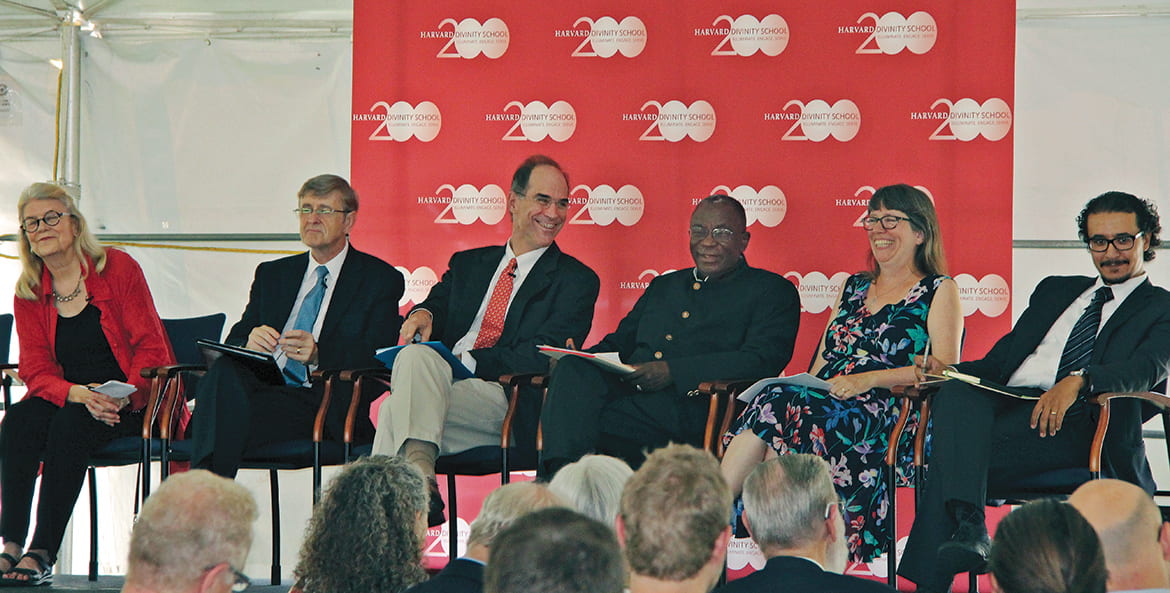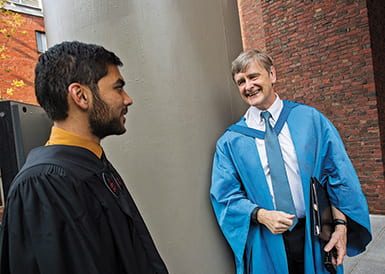
Faculty Panel
What Is a Multireligious Divinity School?
Five Questions to Consider
Faculty panel at 2016 Convocation. HDS photograph/Michael Naughton
By David N. Hempton
I would like to start with a personal story, which I think may sound a little strange to an American audience, though it is more common in other parts of the world. I grew up in a working-class Protestant family in East Belfast and soon entered an educational system that was deeply segregated between Catholics and Protestants (it remains so). Insofar as my memory can be trusted, I have no recollection of ever entering a Catholic school or place of worship before the age of eighteen. The first Catholic place of worship I ever set foot in was as a curious and awestruck tourist to the Cathedral of Santa Maria of Palma on the island of Majorca. To this day, I know that I have visited and attended more worship services in Catholic churches outside of Ireland than within Ireland, despite living the majority of my life in that country.
A quick follow-up to that story. In 1970 I entered Queen’s University Belfast (QUB), a university without a religious studies department, which was founded in the 1840s with the express mandate that it should not teach religion or theology. For that reason, the Queen’s Colleges in Cork, Galway, and Belfast were nicknamed “Godless colleges.” This was done, ironically, to try to appease nonestablished religious traditions and avoid conflict. QUB still does not teach religion or theology, but it does now have an Institute of Theology that coordinates the degrees which Queen’s confers on students from five affiliated denominational colleges (Presbyterian, Evangelical, Baptist, Methodist, and Catholic). Despite being roiled by religious conflict for centuries, the premier university in Northern Ireland still struggles to deal with religion in an academic environment that can bring together Catholic and Protestant students, never mind other world religious traditions.
These educational realities of segregation and denominational exclusivity did not alone cause violence in Ireland, but they have certainly contributed to the separations and stereotypes that often precede and undergird conflict.
In a similar vein, since becoming Dean of Harvard Divinity School, I have received messages from our alumni in different parts of the world expressing their gratitude to HDS for its treatment of religion as a rigorous academic field of human inquiry and for its religious pluralism—neither of which exists in many parts of the world, where the teaching of religion is often the preserve of clerical elites in singular traditions. What these stories suggest to me is that neither complete avoidance of religion nor exclusive or monopolistic sectarian teaching of religion is without its negative consequences.
With those stories in mind, let’s get down to the question. What is a multireligious divinity school? I have five overlapping sets of questions that I think merit attention.
First, there is a terminological problem. There is a paradox in the title itself, because “divinity school” generally connotes Christian, which of course is the religious tradition of the School’s founding and is still its largest tradition as represented by its faculty and students. The phrase multireligious divinity school is therefore somewhat problematic in itself, even if alternatives are very hard to come by. Discussions around nomenclature have mostly resulted in the endorsement of the present title of the School.
Second, what are the compositional desiderata in a multireligious divinity school? HDS’s recent practice has been to appoint professors and enroll students who may be religious practitioners and/or whose primary objective is academic study and scholarship. Some of those professors and students may have no religious beliefs whatsoever and may even be skeptical about religion. That proportion may increase as the share of “nones” and those who are religiously unaffiliated continues to rise in Western societies over the next quarter of a century. Also in terms of composition: who or what gets to determine the “multi” of multireligious and how are those decisions made? Explicitly and consciously, based on principles and objectives, or unconsciously and obliquely, based on cultural adaptation and cultural osmosis? The history of HDS seems to suggest that the students, more than professors or administrators, have driven its increasing pluralism. Moreover, what are the appropriate spatial and geographic parameters of “multireligious?” For example, should a divinity school reflect the religious constituencies of its city, its region, its country of location, or the world as a whole? Does Harvard, and do other universities who aspire to global significance and influence, have different criteria for religious diversity than more specifically regional colleges?

David Hempton talks to Adeel Mohammadi, MTS ‘16, after the 2016 Multireligious Service of Thanksgiving. Photo by Justin Knight
Third, what are the curricular desiderata of a multireligious divinity school? Specifically, how should religion be studied in a multireligious school? At HDS, and certainly within the historical worlds in which I have operated, there has been a strong emphasis on practice or on what we call “lived religion”—that is, religion with all the messiness of diverse practices, cultural expressions, changes over time, and attention to all of the “religion and . . .” questions. Attention to lived religion in all its forms and expressions means that we should also treat current practices seriously, however sharp-edged and exclusive they may be. I do not see it as HDS’s job to promote a kind of neutral syncretism. Differences and disagreements need to be honored, not etherized.
However, I do think that, over time, education in a multireligious academy, simply by learning and seeing the beliefs and practices of other traditions, inevitably places one’s own practice in a larger context. This process need not necessarily compromise commitment and authenticity, but it should facilitate a better understanding of the religious “other” as well as of oneself. Of course, this kind of practical but not ideological relativism may sometimes produce the reverse effect, namely, a doubling down on claims to exclusive truth. But if that happens, that also is acceptable.
Fourth, how does a multireligious school build a community of respect and mutual understanding? In thinking about this, I was drawn back to some of the practical issues we have been dealing with as a community for over a decade. See, for example, the document “Multireligious Etiquette: A Brief Guide to Being at Home in the HDS Community,” which the Office of the Chaplain and Religious and Spiritual Life at HDS has produced. Here are ten practical recommendations dealing with hugging and touching, dietary restrictions, bodies and attire, rituals and practices, and holy days and calendars. The guide encourages us not to essentialize based on religious tradition, to ask questions of others without embarrassment, to expect and make accommodations, to care as much about the sensitivities of others as ourselves, and to contribute to community life rather than retreating into sectarian isolation.
Fifth, I think we should ask the question of ourselves: What would a multireligious academy do that a mono-religious one could not, and vice versa? In a world that is multireligious, an academy that is self-consciously multireligious provides a community context and a curricular content that prepares practitioners and scholars (and combinations of both) for the world into which they will graduate. A multireligious school provides a relatively safe space in which one can experience, study, and work to understand religion in all its complexity and to appreciate difference as a positive reality.
Finally, we need to be careful not to present HDS’s embrace of multireligious diversity as an unalloyed progress narrative. Change often brings pain as well as opportunity. The expansion of diversity for the many can lead to a reduction of cultural familiarity and sense of security for others. One person’s diversity can be another’s vacuous syncretism. In the late Peter Gomes’s 2004 Convocation Address, he identified himself as an “out-of-the-closet Protestant Christian,” and as an African American man who would not have been welcome at HDS in the recent past. At the same time, however, Gomes also experienced other efforts at inclusivity as a loss: “At the start of our faculty meetings,” he stated, “the dean once led in prayer; then we observed silence; and now there is nothing.” Or as Janet Gyatso put it in her 2003 Convocation Address, “we need to think . . . about the distinction between neutralizing sectarian affiliation and eliminating religion altogether.”
Through ongoing debate, struggle, and dialogue over two centuries, the HDS community has somehow decided what it values and what it has defined as religious inclusion, pluralism, and diversity. As the School looks toward the twenty-first century and beyond, these conversations are sure to be complicated, controversial, and contingent upon changes in the social salience of religion, nationally and globally. I am delighted, therefore, that we are beginning our year of bicentennial celebration with this very difficult question. As Dean of HDS, I welcome the debate.
David N. Hempton is Dean of the Faculty of Divinity, Alonzo L. McDonald Family Professor of Evangelical Theological Studies, and John Lord O’Brian Professor of Divinity.
Please follow our Commentary Guidelines when engaging in discussion on this site.

